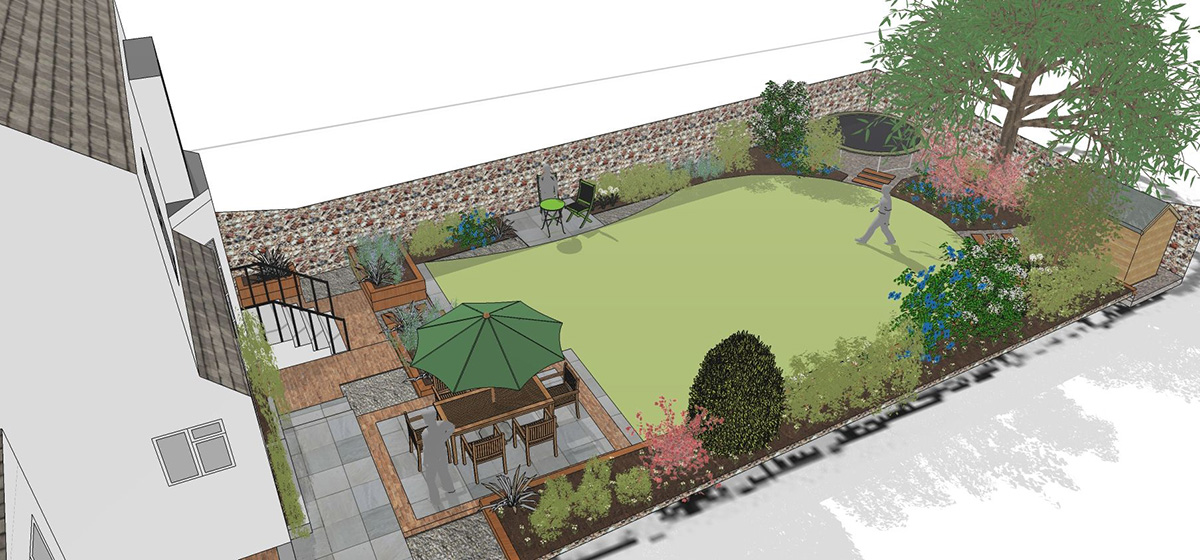Home>Garden Essentials>How To Write Up A Landscaping Contract


Garden Essentials
How To Write Up A Landscaping Contract
Modified: September 1, 2024
Learn the steps to create a comprehensive landscaping contract for your garden. Get expert tips and templates to ensure a successful project.
(Many of the links in this article redirect to a specific reviewed product. Your purchase of these products through affiliate links helps to generate commission for Storables.com, at no extra cost. Learn more)
Introduction
Welcome to the world of landscaping! Whether you are a professional landscaper or a homeowner looking to hire landscaping services, one thing is certain: a well-written landscaping contract is essential.
A landscaping contract serves as a legally binding agreement between the client and the landscaper. It outlines the terms and conditions of the project, ensuring that both parties are on the same page and have a clear understanding of their responsibilities.
While it may seem like a tedious task, taking the time to create a detailed and comprehensive landscaping contract can save you from potential disputes, misunderstandings, and even legal issues down the line.
In this guide, we will walk you through the key components of a landscaping contract and provide valuable insights to help you write up an effective contract. Whether you are a landscaper or a client, understanding these elements will empower you to protect your interests and ensure a successful landscaping project.
So, let’s dive in and explore the importance of a landscaping contract and the key components that should be included in it.
Key Takeaways:
- A landscaping contract is crucial for clear expectations, legal protection, and budget control. It ensures a successful project by defining responsibilities and timelines.
- Including client information, defining scope of work, and establishing payment terms are key components of a landscaping contract. Clear communication and legal protection are essential for a successful project.
Read more: How To Write A Contract For Home Renovation
Understanding the Importance of a Landscaping Contract
When embarking on a landscaping project, it is easy to get caught up in the excitement of transforming your outdoor space. However, it is crucial to remember that landscaping is a business transaction, and protecting your interests should be a top priority. This is where a landscaping contract comes into play.
A landscaping contract serves as a crucial tool to establish clear expectations, protect both the client and the landscaper, and prevent any potential disputes or misunderstandings. Let’s take a closer look at why a landscaping contract is so important:
- Clarity and Communication: A well-drafted landscaping contract ensures that both parties have a mutual understanding of the scope of work, timeline, and specific details of the project. It clarifies the responsibilities of both the client and the landscaper, eliminating any confusion or assumptions.
- Legal Protection: By having a written agreement in place, both the client and the landscaper are protected legally. The contract outlines the agreed-upon terms, including payment details, project milestones, and warranties, serving as evidence in case of any disputes or disagreements.
- Scope and Budget Control: A detailed landscaping contract outlines the specific tasks to be completed, materials to be used, and any additional services or changes requested by the client. This helps control the scope of the project and prevents any unexpected costs or changes.
- Timeline and Deadlines: A landscaping contract includes a clear timeline for the project, specifying start and completion dates, important milestones, and any penalties or incentives related to meeting deadlines. This ensures that both the client and the landscaper are aware of the expected timeframe.
- Professionalism and Accountability: When both parties sign a landscaping contract, it establishes a level of professionalism and accountability. It shows that the landscaper is serious about delivering quality work and that the client is committed to fulfilling their financial obligations.
Overall, a well-crafted landscaping contract provides peace of mind for both the client and the landscaper. It sets clear expectations, protects both parties from potential disputes, and ensures that the project runs smoothly and successfully.
Now that we understand the importance of a landscaping contract, let’s delve into the key components that should be included to create a comprehensive and effective agreement.
Key Components of a Landscaping Contract
A well-written landscaping contract should cover all the necessary details and specifications of the project. It should be clear, concise, and comprehensive. Here are the key components that should be included:
- Client Information: Start the contract by including the full contact information of the client, including their name, address, phone number, and email. This ensures that the contract is specific to the client and helps identify the parties involved.
- Scope of Work: Clearly define the scope of work to be performed. This includes a detailed description of the landscaping services, such as lawn maintenance, planting, hardscaping, irrigation, and any other specific tasks agreed upon. Be specific about the size and location of the project area as well.
- Timeline: Include a timeline for the project, specifying the start date, estimated completion date, and any important milestones or deadlines. This helps both parties understand the expected timeframe and plan accordingly.
- Materials and Equipment: Specify the materials, plants, and equipment that will be used in the project. Include details such as the types of plants, brand of materials, and any specific requirements or preferences agreed upon by the client. This ensures clarity and avoids misunderstandings.
- Payment Terms and Schedule: Clearly outline the payment terms, including the total project cost, any deposit or upfront payment required, and the schedule of payments. Specify acceptable payment methods and any penalties for late payments or non-payment.
- Changes and Amendments: Address how changes or amendments to the contract will be handled. Specify whether changes must be made in writing, how additional costs or time extensions will be determined, and how any disputes related to changes will be resolved.
- Termination Clause: Include a termination clause that outlines the conditions under which either party can terminate the contract. Specify any notice periods and whether any penalties or refunds apply in case of termination.
- Insurance and Liability: Detail the insurance coverage held by the landscaper, including general liability insurance and workers’ compensation. Clarify any limitations or exceptions to liability and specify the responsibility of each party in case of damages or accidents.
- Dispute Resolution: Include a clause that outlines how disputes will be resolved, whether through mediation, arbitration, or in accordance with the laws of a specific jurisdiction. This helps prevent legal complications and encourages amicable resolutions.
- Signatures and Execution: End the contract with spaces for both parties to sign and date the agreement. This confirms that both the client and the landscaper have read, understood, and agreed to the terms and conditions of the contract.
By including these key components in your landscaping contract, you can ensure that all the important aspects of the project are covered and that both parties are clear on their obligations and responsibilities. Remember, it is always advisable to consult with a legal professional to ensure that your contract is legally sound and meets all necessary requirements.
Now that we have explored the essential components of a landscaping contract, you are well-equipped to write up an effective agreement for your landscaping project. Follow these guidelines and adapt them to fit your specific needs, and you’ll be on your way to a successful and hassle-free landscaping experience.
Client Information
The first key component of a landscaping contract is to include detailed client information. This section ensures that the contract is specific to the client and helps identify the parties involved. Here are the essential details to include:
- Client’s Full Name: Start by stating the full legal name of the client. This could be an individual, a company, or an organization. Ensure that the name is spelled correctly to avoid any confusion.
- Client’s Contact Information: Include the client’s address, phone number, and email address. This information is vital for communication purposes and for sending official correspondence related to the landscaping project.
- Client’s Billing Address: Specify the billing address if it differs from the client’s residential or mailing address. This allows for accurate invoicing and ensures that payments are sent to the correct location.
- Client’s Legal Representative (if applicable): If the client is a company or organization, include the name and contact details of the primary legal representative or person authorized to sign the contract on behalf of the client.
- Client’s Preferred Communication Method: It may be helpful to include the client’s preferred method of communication, whether it is through phone calls, emails, or in-person meetings. This helps establish effective communication channels throughout the project.
Ensuring that accurate and up-to-date client information is included in the landscaping contract helps create a clear understanding of the parties involved. It also allows for efficient communication and helps prevent any misunderstandings or errors related to client identification.
In addition to the client’s information, it is important to include the landscaper’s information as well. This includes details such as the company name, address, phone number, and email. If the landscaper is an individual, include their full name and contact information. This ensures that both parties are identified and can be reached throughout the course of the project.
Remember to maintain privacy and confidentiality when handling client information. Ensure that you comply with any applicable data protection laws and regulations and clearly state your commitment to keep the client’s information confidential within the contract.
Now that you understand the importance of including client information in a landscaping contract, you can confidently proceed to the next component: defining the scope of work.
Scope of Work
The second key component of a landscaping contract is defining the scope of work. This section outlines the specific tasks and services that the landscaper will provide to the client. Clearly defining the scope of work ensures that both parties have a mutual understanding of the project’s objectives and deliverables. Here are the essential elements to include:
- Detailed Description: Provide a detailed description of the landscaping services to be performed. This may include tasks such as lawn maintenance, planting, irrigation system installation, hardscaping, landscape design, or any other specific services agreed upon between the client and the landscaper.
- Size and Location: Specify the size and location of the project area. This could include measurements of the lawn, garden, or outdoor space where the landscaping work will take place. This information helps both parties understand the scale of the project and ensures there are no misunderstandings regarding the boundaries of the work area.
- Materials and Plants: Indicate the specific materials, plants, and equipment that will be used in the project. This includes items such as soil, mulch, stones, trees, shrubs, flowers, and any other materials necessary to complete the landscaping work. If there are specific brand preferences or any restrictions on the use of certain materials, be sure to include that information as well.
- Project Timeline: Clearly define the timeline for the project, including the expected start date and estimated completion date. Additionally, consider including key project milestones or deadlines for specific phases of the work. This helps both the client and the landscaper to have a clear understanding of the project timeline and ensures that expectations regarding project completion are aligned.
- Exclusions: It is equally important to specify what is not included in the scope of work. This could include any tasks or services that the landscaper will not be responsible for. Clearly outlining the exclusions helps prevent any confusion or misunderstandings about what the landscaper is expected to deliver.
- Change Requests: State how change requests will be handled. If the client wants to make changes to the original scope of work during the course of the project, specify the process for requesting and approving changes. Also, clarify how additional costs or time extensions resulting from change requests will be addressed.
By including these elements in the scope of work section of the landscaping contract, both the client and the landscaper can have a clear understanding of the tasks to be performed, the materials to be used, and the expected timeline. This helps prevent any misunderstandings or disagreements regarding the scope of the project and ensures that both parties are aligned in their expectations.
Once you have clearly defined the scope of work, the next component to consider is establishing a timeline for the project. This ensures that both parties are aware of the expected timeframe and can plan accordingly.
Timeline
The third key component of a landscaping contract is establishing a timeline for the project. A well-defined timeline ensures that both the client and the landscaper have a clear understanding of the project’s duration and key milestones. This section helps set expectations and allows for effective project planning. Here are the essential elements to include when outlining the timeline:
- Start Date: Specify the anticipated start date of the project. This is the date on which the landscaper will begin the work outlined in the contract. It is important to be realistic and consider any external factors that may impact the start date, such as weather conditions.
- Estimated Completion Date: Provide an estimated completion date for the project. This is the date when the landscaper anticipates that all the agreed-upon work will be completed. It is important to remember that landscaping projects can be subject to delays, so this date should be considered an estimate.
- Milestones or Phases: If the project consists of distinct phases or milestones, outline them in the timeline section. For example, if there are different stages of planting, hardscaping, or irrigation system installation, specify when each phase is expected to be completed.
- Delivery Dates for Materials: If specific materials or plants need to be sourced or ordered for the project, include the delivery dates in the timeline. This ensures that the landscaper has the necessary resources on time and can plan the work accordingly.
- Work Hours and Duration: Clearly define the expected work hours and the duration of work each day or week. This helps the client to understand the expected level of disruption to their daily routine and allows the landscaper to plan their work schedule effectively.
- Allowance for Unforeseen Circumstances: It is important to acknowledge that unforeseen circumstances may arise during the project that could impact the timeline. This could include inclement weather, material availability issues, or unexpected site conditions. Specify how such situations will be handled and whether there is flexibility in the timeline to accommodate these unforeseen events.
By establishing a clear and realistic timeline, both the client and the landscaper can understand the expected duration of the project and plan accordingly. It provides a framework for progress tracking and helps keep everyone accountable. Regular communication between the client and the landscaper throughout the project can help address any deviations from the timeline and ensure that the project stays on track.
Now that we have discussed the timeline, the next key component to consider in a landscaping contract is the inclusion of materials and equipment details.
Materials and Equipment
In a landscaping contract, it is essential to provide clear details about the materials and equipment that will be utilized throughout the project. Specifying the necessary materials ensures that both the client and the landscaper are on the same page regarding the quality and type of materials to be used. Here are the key points to include:
- Types of Materials: List the specific types of materials that will be used for the landscaping project. This may include soil, mulch, stones, grass seed, plants, trees, and any other materials necessary for the completion of the project. Specify any specific brand preferences or requirements that the client may have.
- Quality and Standards: If there are any specific quality standards that need to be adhered to for the materials, state them explicitly in the contract. This ensures that both parties have a shared understanding of the expected quality of the materials used.
- Delivery and Storage: Outline how the materials will be delivered to the project site and where they will be stored, if applicable. Clarify whether the delivery and storage costs are included in the overall project cost or if they are separate and if the client is responsible for securing any necessary permits for storage.
- Plant Selection: If there is a specific selection of plants or trees that will be used, provide a detailed list that includes the types, sizes, and quantities. If certain plants are unavailable or out of season, state how alternatives will be chosen and approved by the client.
- Equipment: Outline any specialized equipment or machinery required for the project. This may include irrigation systems, machinery for grading or excavation, or any other tools specific to the landscaping tasks. Discuss who will provide the equipment and any associated costs or liabilities.
- Responsible Party: Clarify who will be responsible for procuring the materials and equipment. Specify if it is the client’s responsibility or if the landscaper will handle the procurement. If the landscaper is responsible, outline whether the cost of the materials and equipment is included in the overall project cost or if they will be billed separately.
By including these details about materials and equipment in the landscaping contract, both the client and the landscaper will have a clear understanding of what is required for the project. This helps prevent any misunderstandings or discrepancies regarding the quality, type, and source of materials to be used.
It is important to be specific and thorough in describing the materials and equipment to be utilized. The more clarity there is in this section, the smoother the procurement process will be, and the more likely it is that the project will be executed according to the client’s expectations.
Now that we have covered the materials and equipment details, let’s move on to the next component: payment terms and schedule, an important aspect of any landscaping contract.
Be sure to include a detailed description of the work to be done, the timeline for completion, payment terms, and any warranties or guarantees in your landscaping contract.
Payment Terms and Schedule
When it comes to a landscaping contract, clearly outlining the payment terms and schedule is crucial in ensuring a smooth working relationship between the client and the landscaper. This section specifies the financial obligations and expectations of both parties. Here are the key details to include:
- Total Project Cost: Clearly state the total cost of the landscaping project. This is the overall amount that the client will be responsible for paying for the completion of the agreed-upon services and materials.
- Payment Breakdown: Provide a breakdown of how the total project cost will be divided. This could be structured in different ways, such as a percentage-based breakdown per phase of the project, specific milestones, or a percentage upfront with remaining payments upon completion.
- Deposit or Upfront Payment: Specify whether a deposit or upfront payment is required, and if so, the amount and due date. This ensures that the landscaper has some financial security before commencing work and helps cover initial costs such as material procurement or equipment rental.
- Schedule of Payments: Outline the specific dates or milestones when payments are due. This helps ensure that both parties are aware of their financial obligations and can plan accordingly. Consider including specific details such as payment due dates, acceptable payment methods, and any penalties or incentives for early or late payments.
- Additional Costs: Address any potential additional costs that may arise during the course of the project. This could include unforeseen changes to the scope of work, such as additional features or materials requested by the client. Specify how these additional costs will be calculated, approved, and billed.
- Retention of Payment: Discuss if any portion of the payment is to be held as retention until the completion of the project. Retention payments are common in the landscaping industry and are usually released after a designated period to ensure that the work has been completed satisfactorily.
- Late Payments: Clarify any penalties or charges that may apply in case of late payments. This is important to ensure that both parties understand the consequences of delayed or missed payments and to maintain mutual accountability.
By including these payment terms and schedule details in the landscaping contract, both the client and the landscaper have a clear understanding of the financial aspects of the project. This helps prevent any misunderstandings or disputes related to payments and ensures that the project can progress smoothly.
It is crucial to discuss and agree upon these payment terms before commencing the project. By setting clear expectations and providing transparency regarding financial matters, you can establish a strong foundation for a successful working relationship.
Now that we have covered the payment terms and schedule, let’s move on to the next important component: changes and amendments.
Changes and Amendments
Changes are inevitable in any landscaping project, and it is essential to have a well-defined process for handling changes and amendments to the original contract. This section of the landscaping contract outlines how any modifications or adjustments to the scope, timeline, or cost of the project will be addressed and agreed upon. Here are the key details to include:
- Change Request Process: Specify the process by which changes or amendments to the original contract will be requested. This could include submitting a written request detailing the requested changes, the rationale behind them, and any additional cost or time implications.
- Approval Procedures: Clearly state the process for reviewing and approving change requests. Outline who has the authority to approve or reject the changes and the timeframe within which a decision will be made.
- Additional Costs: Address how additional costs resulting from changes will be calculated, presented, and approved. Specify whether a change order will be issued, detailing the revised cost breakdown, or if additional costs will be estimated and invoiced separately.
- Impact on Timeline: Discuss how changes requested by the client may impact the project timeline. Specify whether additional time will be required to accommodate the changes and how the revised timeline will be communicated to the client.
- Client Approval: Clearly state that any changes to the scope, timeline, or cost of the project must be approved in writing by the client. This ensures that there is documented agreement and acknowledgment of the changes.
- Documentation: Emphasize the importance of maintaining written documentation for all changes and amendments. This could include change request forms, change orders, or any other written communication that outlines the agreed-upon modifications.
By including these details in the changes and amendments section of the landscaping contract, both the client and the landscaper have a clear understanding of how modifications will be handled. This helps ensure that all changes to the original contract are documented, approved, and properly communicated. It also provides a transparent process for managing any adjustments to the project.
It is crucial to address changes promptly and document them properly to prevent any misunderstandings or disputes in the future. By proactively addressing changes through a predefined process, both the client and the landscaper can maintain a positive working relationship and ensure that the project progresses smoothly.
Now that we have covered changes and amendments, let’s move on to the next component: the termination clause.
Read more: How To Find Landscape Design Contracts
Termination Clause
The termination clause is an important component of a landscaping contract as it outlines the conditions under which either party can terminate the agreement. This section provides clarity on the circumstances and procedures for ending the contract prematurely. Here are the key details to include:
- Termination Rights: Clearly state the rights of both the client and the landscaper to terminate the contract. This could be for any reason or under specific circumstances outlined in the clause.
- Notice Period: Specify the required notice period that either party must provide in the event of termination. This allows both parties to plan for the transition and make any necessary arrangements.
- Procedure: Outline the procedure for terminating the contract, including how the termination notice should be delivered and to whom. This ensures that the termination is done in a formal and documented manner.
- Consequences of Termination: Discuss the consequences of terminating the contract, such as the payment of any outstanding amounts, the return of any equipment or materials, or the settlement of any disputes. Clearly state any penalties or obligations that arise upon termination.
- Refund Policy: If applicable, detail any refund policy in the event of termination. Specify whether a partial or full refund of any deposits or prepaid amounts will be granted, or if there are any deductions or expenses that may be withheld.
- Confidentiality: Emphasize the need to maintain confidentiality even after termination. Both parties should agree to keep any confidential information obtained during the course of the project confidential, even after the contract has been terminated.
By including a well-defined termination clause in the landscaping contract, both the client and the landscaper can have peace of mind knowing that there is a clear process for ending the agreement if necessary. It establishes clear expectations and safeguards the interests of both parties.
It is important to carefully review and negotiate the termination clause before signing the contract. Both the client and the landscaper should understand their rights and obligations in relation to termination to avoid any disputes or complications in the future.
With the termination clause in place, we now move on to the next component: insurance and liability, an important aspect of any landscaping contract.
Insurance and Liability
Insurance and liability provisions are crucial components of a landscaping contract as they define the responsibilities and protections for both the client and the landscaper. This section outlines the insurance coverage held by the landscaper and addresses liabilities in case of damages or accidents during the project. Here are the key details to include:
- Insurance Coverage: Specify the insurance policies maintained by the landscaper, such as general liability insurance and worker’s compensation insurance. This helps protect both parties in the event of property damage, bodily injury, or accidents during the project.
- Proof of Insurance: Require the landscaper to provide proof of insurance coverage, such as certificates of insurance, before commencing work. This ensures that the client is aware of the landscaper’s insurance coverage and provides peace of mind.
- Liability Limitations: Discuss any limitations or exclusions of liability. This could include circumstances where the landscaper is not liable for damages or delays caused by factors beyond their control, such as extreme weather events.
- Indemnification: Outline the indemnification provisions, which state that the landscaper will indemnify and hold the client harmless against any claims, damages, or liabilities arising from the landscaper’s negligence or failure to comply with the contract.
- Client’s Responsibilities: Clarify any responsibilities or obligations of the client related to insurance and liability. This may include ensuring that the property is safe and accessible for the landscaper and promptly reporting any concerns or hazards that may affect the project or the safety of the workers.
- Dispute Resolution: Specify how disputes related to insurance and liability will be resolved. This may include mediation, arbitration, or litigation. Clearly state the jurisdiction or laws that will govern any legal proceedings.
By including these insurance and liability provisions in the landscaping contract, both the client and the landscaper are protected in case of unforeseen events or accidents. These provisions ensure that there is transparency and understanding regarding the insurance coverage and liabilities associated with the project.
It is important for both parties to review these provisions carefully before signing the contract. If needed, consult with legal professionals to understand the insurance coverage and liability implications that exist in your specific jurisdiction or circumstances.
With the insurance and liability provisions addressed, we move on to the next important component: dispute resolution.
Dispute Resolution
Disputes can sometimes arise during a landscaping project, and having a well-defined dispute resolution process in the contract is essential. This section outlines the steps to be taken in case of disagreements or conflicts between the client and the landscaper, providing a framework for resolving disputes efficiently and amicably. Here are the key details to include:
- Mediation: Specify that, in the event of a dispute, both parties agree to enter into mediation as the initial step for resolution. Mediation involves a neutral third party who helps facilitate communication and negotiation to assist in reaching a mutually satisfactory agreement.
- Arbitration or Litigation: If mediation fails to resolve the dispute, outline the process for further dispute resolution, such as arbitration or litigation. Specify the jurisdiction or laws that will govern any legal proceedings.
- Costs: Clarify how the costs associated with mediation, arbitration, or litigation will be allocated between the parties. This may include specifying that each party will be responsible for their own legal fees or outlining a shared responsibility for the costs.
- Enforcement of Decisions: State that any decisions reached through mediation, arbitration, or litigation will be binding and enforceable. This ensures that the resolution reached is legally valid and can be implemented accordingly.
- Continuation of Work: Discuss the approach to be taken regarding the continuation of work during the dispute resolution process. Depending on the nature of the dispute, it may be reasonable to pause or seek agreement on specific aspects of the project until a resolution is reached.
- Communication: Emphasize the importance of open and respectful communication throughout the dispute resolution process. Encourage both parties to maintain professionalism and engage in constructive dialogue to find a resolution.
By including these dispute resolution provisions in the landscaping contract, both the client and the landscaper have a predetermined process to follow in case of conflicts or disagreements. Having these provisions in place helps mitigate the potential for escalating disputes and encourages efforts to find mutually satisfactory resolutions.
In the event of a dispute, it is advisable for both parties to seek legal advice and follow the agreed-upon dispute resolution process outlined in the contract. This can help save time, money, and potentially prevent the need for formal litigation.
With the dispute resolution provisions established, we move on to the final component: signatures and execution.
Signatures and Execution
The final component of a landscaping contract is the signatures and execution section. This section ensures that the contract is legally binding and officially executed by both parties involved. Here are the key details to include:
- Signature Blocks: Create space for the client and the landscaper to sign and date the contract. Include their printed names beneath the signature lines for clarity and identification.
- Date of Execution: Specify the date when the contract is signed by both parties. This serves as a reference for the official commencement of the contractual relationship.
- Authorized Signatory: If the client is a company or organization, ensure that the person signing the contract is authorized to do so on behalf of the client. Include their position or role within the organization.
- Witnesses: If desired or required by local regulations, include space for witnesses to sign and date the contract. This serves to validate the execution of the contract.
- Retention of Copies: Specify how many copies of the contract will be signed, and indicate that each party will retain a copy for their own records. This helps ensure that both parties have a documented version of the contract.
By including this section in the landscaping contract, both the client and the landscaper formally acknowledge their agreement to the terms and conditions outlined in the contract. Signatures indicate the parties’ understanding and acceptance of the contractual obligations they are entering into.
It is recommended that both parties carefully review the entire contract before signing to ensure they understand and agree to its contents. If any amendments or clarifications are necessary, they should be addressed and incorporated into the contract before the final execution.
Once the contract is signed by both parties, make sure to provide each party with a copy for their records. Keep the signed contract in a secure location for future reference, as it serves as the official agreement between the client and the landscaper.
Congratulations! With the signatures and execution section completed, you have now covered all the essential components of a landscaping contract. Remember to consult with a legal professional to ensure that your contract adheres to local laws and regulations for added protection and peace of mind.
By creating a thorough and well-crafted landscaping contract, you lay the foundation for a successful and mutually beneficial landscaping project. Clear expectations, defined responsibilities, and comprehensive terms and conditions foster a positive working relationship between the client and the landscaper.
Now it’s time to put your knowledge into action and create a landscaping contract that reflects the specifics of your project. Good luck!
Read more: How To Write A Bid For Landscaping
Conclusion
Congratulations on reaching the end of this guide to writing a comprehensive landscaping contract. By now, you should have a good understanding of the key components that should be included in your contract to protect the interests of both the client and the landscaper.
A well-written landscaping contract serves as a vital tool in setting clear expectations, preventing disputes, and ensuring a successful project. It provides a framework for communication, documentation, and accountability, allowing both parties to navigate the landscaping process with confidence.
Throughout this guide, we have discussed the importance of including client information, defining the scope of work, establishing a timeline, specifying materials and equipment, outlining payment terms, addressing changes and amendments, establishing insurance and liability provisions, defining dispute resolution procedures, and finalizing the contract with signatures and execution.
However, it is important to note that while this guide provides a comprehensive framework, every landscaping project is unique, and your contract should be tailored to the specific details of your project. Consulting with legal professionals to ensure compliance with local laws and regulations is highly recommended.
Remember, a well-crafted landscaping contract not only protects both the client and the landscaper, but it also sets the stage for a successful and mutually beneficial working relationship. Open and transparent communication, professionalism, and a commitment to meeting agreed-upon obligations contribute to a positive experience for all parties involved.
Now it’s time to put your newfound knowledge into practice and write up a landscaping contract that suits your project’s requirements. Take the time to consider each component carefully, making sure to address any specific details or concerns relevant to your situation.
Remember, a well-written and thoroughly reviewed contract will help pave the way for a smooth and successful landscaping project. Best of luck, and here’s to a beautiful and inspiring outdoor space!
Frequently Asked Questions about How To Write Up A Landscaping Contract
Was this page helpful?
At Storables.com, we guarantee accurate and reliable information. Our content, validated by Expert Board Contributors, is crafted following stringent Editorial Policies. We're committed to providing you with well-researched, expert-backed insights for all your informational needs.













0 thoughts on “How To Write Up A Landscaping Contract”